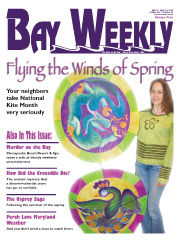Chesapeake Bay's Independent Newspaper ~ Since 1993
1629 Forest Drive, Annapolis, MD 21403 ~ 410-626-9888
Volume xviii, Issue 14 ~ Apri 8 to April 14, 2010
Home \\ Correspondence \\ from the Editor \\ Submit a Letter \\ Classifieds \\ Contact Us
Best of the Bay \\ Dining Guide \\ Home & Garden Guide \\ Archives \\ Distribution \\ Advertising![]()


Sky Watch

by J. Alex Knoll
The Celestial Seasons
These stars tell time like a torn-away calendar page
The moon wanes through pre-dawn skies, rising a little after 4am Friday and roughly 25 minutes later the next few nights. Then, on the 14th, the new moon disappears within the glare of the sun.
Early Sunday morning, the tips of the thin crescent moon point up, while brilliant Jupiter shines just five degrees below the crescent’s bowl — close enough to watch both in a pair of binoculars. Then, within an hour of rising, first Jupiter, then the moon blink from view with sunrise at 6:35.
The moonless nights leave a dark backdrop for the constellations of spring. By 10pm, question mark-shaped Leo shines directly overhead, punctuated by blue-white Regulus, the lion’s heart.
Perhaps no other constellation is tied to spring as much as Virgo. Goddess of the harvest, she grieves for her daughter, stolen away and destined to dwell the six months of winter in the underworld of Hades. Now, as weather warms and daylight grows, brilliant Virgo hovers in the east at sunset, around 7:40 this week. While Virgo is the second-largest constellation, only blue-white Spica stands out above first magnitude
In later evening, yellow-orange Arcturus of Boötes the herdsman twinkles high in the east. While a herdsman returning with his flock to the fields seems synonymous with spring, who has heard of a bear-herder? But people long ago saw this simple, diamond-shaped figure as the bear keeper or bear herder, tending to the bruins Ursa Major and Ursa Minor higher overhead.
While Ursa Major and Ursa Minor are visible year-round — called circumpolar — they play a neat springtime trick each April. Ursa Minor, commonly called the Little Dipper, hovers with its bowl facing the celestial zenith, where stands the Big Dipper, Ursa Major, pouring the contents of its bowl into that of the Little Dipper.
Illustration: © Copyright 1925 M.C. Escher/Cordon Art-Baarn-Holland; Graphics: © Copyright 2010 Pacific Publishers. Reprinted by permission from the Tidelog graphic almanac. Bound copies of the annual Tidelog for Chesapeake Bay are $14.95 ppd. from Pacific Publishers, Box 480, Bolinas, CA 94924. Phone 415-868-2909. Weather affects tides. This information is believed to be reliable but no guarantee of accuracy is made by Bay Weekly or Pacific Publishers. The actual layout of Tidelog differs from that used in Bay Weekly. Tidelog graphics are repositioned to reflect Bay Weekly’s distribution cycle.Tides are based on National Oceanic and Atmospheric Administration and are positioned to coincide with high and low tides of Tidelog.
© COPYRIGHT 2010 by New Bay Enterprises, Inc. All rights reserved.
